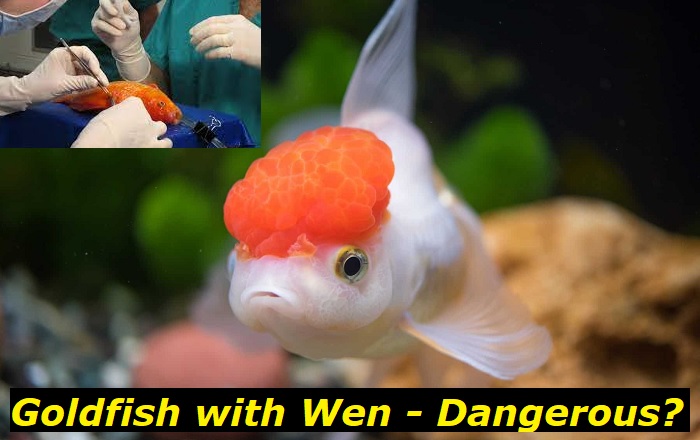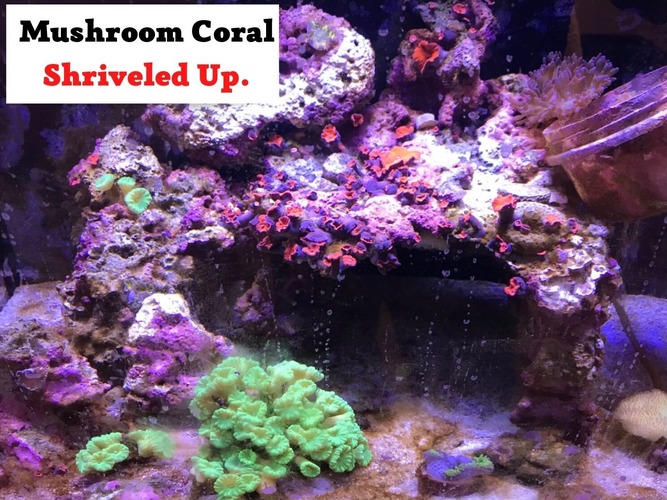We all love Goldfish. They were usually the first pet many of us got. The goldfish originated in China and was later introduced to Japan in the 1600s. Europe started using goldfish for aesthetics in their ponds and Fountains.
On the Lunar New Year in Vietnam, people buy a goldfish for each member of their family. They then take the goldfish to the rivers nearby and set them free with good wishes and good luck. The idea is that the fish will pass along all necessary messages to the spirit realm.

Goldfish are domesticated from Crucian carp, which means a goldfish is essentially a carp. Today we’re going to take a look at the goldfish and the ‘wen’ that grows on its head.
What Is Wen On Goldfish?
Hold on to your hats, because you are about to read the most interesting information for the day.
What is Wen?
Wen, originally a genetic mutation, was later bred into what we now know as the Oranda goldfish. It is a bubble-like mass, that grows on the Oranda’s head and cheeks. In extreme cases, the wen outgrows the fish’s frame.
Due to this phenomenon, the Oranda has become one of the most sought-after goldfish. The growth of a young Oranda might take up to two years to grow, and in some cases can encapsulate the eyes. Take extreme caution to ensure that bacterial infections don’t occur.
Does Wen Grow on All Goldfish?
No, it grows on some goldfish species, not on all. There isn’t much information about why this happens. If you are interested in getting a goldfish with wen, you can look at the Lion head goldfish, the Ranchu goldfish, and of course the Redcap Oranda.
It is important to keep note of your Oranda’s eyesight. Placing an Oranda with poor eyesight in a tank with able-sighted fish might cause your Oranda to starve. Due to the competition of sight-able fish, it will be facing the struggle of not reaching its feed in time.
Should You Trim Wen?
In some cases, you’ll most likely be required to trim your goldfish’s wen at least two times in its lifetime. Some Orandas have excessive growths and need a bit more attention.
Be careful of the decor placed in their tanks to not be too abrasive or prickly, ultimately harming your goldfish.
Experienced Oranda breeders prefer to trim the wen themselves. They use scissors, cleaned and covered with peroxide. Veterinarians would use a scalpel.
Wen Trimming or Removal
Trimming or removing the wen should only be done in extreme cases. The saying goes: If it ain’t broke, don’t fix it. If your goldfish is visibly uncomfortable, can’t see, or having trouble swimming you might want to get that wen trimmed, possibly removed.
Trimming The Wen
The tissue that the Wen consists of is quite thick and can make it difficult to cut. You have to place the fish under anesthetics before you attempt to trim or remove the Wen. Trimming the Wen should be done at least twice a year or when the fish can no longer see or swim very well.
When the Wen grows too large it can obscure the gills and nose, weighing the fish down and causing discomfort. You can do the trimming yourself, just be sure to follow the steps and to be careful. You will need small Sharp scissors, A tweezer, Hydrogen Peroxide, clean/ Decontaminated tank for recovery.
Removing The Wen
In the event of parasites or infection, the wen might need to be removed completely. Due to the nature of the Wen, parasites, and worms can latch easily on to the growth. Salts and medicine cannot penetrate the wen so parasites and worms keep festering.
In order to cure the fish of these ailments, you will need to cut the wen back as much as possible or remove it completely. Don’t worry, this causes very little to no bleeding. It is recommended however to leave this to a professional as you don’t want to hurt your fishy friend.
Does Wen Trimming Hurt?
The wen is just fatty material and if you anesthetize the goldfish properly it shouldn’t hurt. It’s quite a time-sensitive procedure though because if you take too long, your goldfish may ultimately suffocate and die.
You need to have steady hands and a strong stomach. Due to the consistency of wen, you might cringe at the crunchy popping happening at your hand
Breeding Goldfish with Wen
It should be known that not all goldfish grow a wen, even if you have an Oranda there is a chance that it might not grow a wen. So how can you be sure that your goldfish will grow a wen?
It’s always safer to get anything from a trusted source. Going to your local aquarium or fish store is a good idea. There, you can also ask questions about the trimming procedure, how long wen takes to grow, and how to maintain it.
Can I Enhance the Growth of Wen?
Naturally, your goldfish should start growing its wen at around three to four months. It will continue growing for about two to three years. Your last priority should be to enlarge the Wen of a goldfish. It can become uncomfortable, and infected with bacteria, worms, and parasites.
You should always let the wen grow naturally. Your only priority should be to allow your goldfish to reach its full potential in a natural, stress-free way. Don’t give it too much protein either, its diet should be balanced and healthy.
Wen Infections
Because of the folds and crevices on wen, goldfish are prone to infection in the wen tissue. As with any pet, the general rule is to keep their surroundings clean and livable. This is even more true for the goldfish who grow wen.
Goldfish with wen need immaculately clean water, clean substrates to keep infection at the lowest level possible, low nitrates, and a wen-friendly habitat. Meaning the tank should be clear of any and all sharp objects, abrasive surfaces, and able-sighted goldfish.
Tiny white spots on wen are normal, that is usually where new wen growth takes place. Lesions, black spots, or wen with fluffy fibers or fuzzy textures are not normal though, and should be checked out. Most bacterial infections can be fought with antibiotics, but in some cases, your fish might need to be humanly euthanized, or if possible, to have its wen completely removed.
Providing Proper Care for Goldfish With Wen
Most problems you could face with your goldfish can typically be traced to the quality of the water and the cleanliness of its environment. Firstly, it is known that goldfish are quite resilient and can withstand many things from colder temperatures to other aggressive fish. But goldfish with wen are another story.
Before you add your new fish to its tank, you have to get the tank cycled. This can take anything from 6 to 8 weeks. Like any other living creature, goldfish produce waste. Now, in nature, this isn’t a concern because there is so much water that the fish will always get a clean supply of naturally cycled water.
However, in a domesticated setting, you will now have to take on the role of mother Gaia. You need to cycle your water every time a new fish is added to the tank. Failing to do so, will dramatically increase the ammonia levels in your tank, ultimately poisoning and killing your goldfish way before its time.
Final words
There are numerous online groups, resources, and information about goldfish and their wen. You should always make an informed decision before taking on the responsibility of caring for another being, whether it be a fish or frog. Knowing what you need to properly take care of another life is essential, especially if you want to do it the right way without having a guilty conscience.
- High Nitrite and No Ammonia in Aquarium: What Are the Reasons? - May 2, 2023
- Mystery Snail Shell Peeling – What’s Wrong with Your Pet? - September 26, 2022
- What is Wen on Goldfish? Investigating The Fish with the Hood - June 20, 2022




